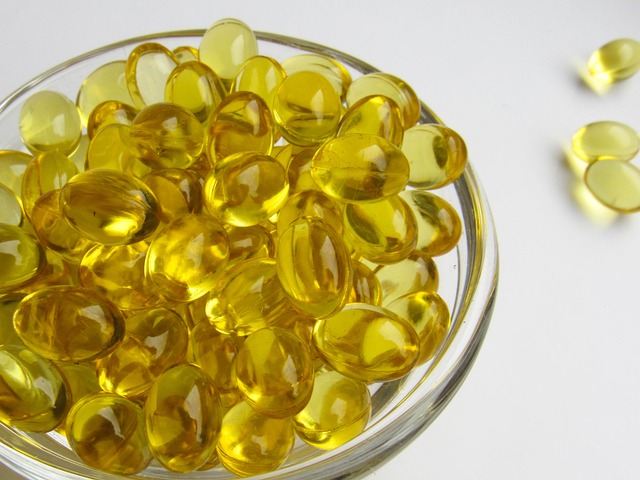Hey everyone. Sorry for not posting a blog for the past few weeks, but I was on vacation in Guatemala. Also, I figured everyone would be busy with the holidays and not get a chance to read a new blog. But I am back and should be posting a new blog every Sunday. This week’s blog is about the importance of vitamin D. Enjoy!
I get blood work done every six months or so. I was surprised to find out I had extremely low vitamin D levels. I went outside during the summer every day, so I figured that would be enough to keep my vitamin D levels up. After some research, I found out how common vitamin D deficiency is and all the important roles vitamin D plays in our body, besides its well-known effects on bone health. I feel that the importance of vitamin D should be stressed over other vitamins because it occurs in so few foods and the rates of deficiency are so high. So what makes this vitamin so important? Read to find out!
Vitamin D and bone health
Vitamin D is called the sunshine vitamin because strong enough sunlight is capable of causing vitamin D production in our skin. Vitamin D is a fat-soluble vitamin similar in chemical structure to cholesterol. We need adequate fat in our diet to make and absorb vitamin D. Vitamin D is needed for bone growth and remodeling and prevents bones from becoming brittle, bent, and thin (which occurs in vitamin D deficiency). Vitamin D is also responsible for maintaining serum calcium and phosphate levels, which are needed to enable normal mineralization (hardening through mineral deposits) of bone. Some other roles vitamin D plays are that it reduces inflammation, modulates cell growth, and keeps a healthy immune system.
How vitamin D affects calcium levels
Vitamin D plays a gigantic role in our body’s maintenance of calcium levels. When our body senses low calcium levels, the parathyroid gland releases parathyroid hormone, which activates vitamin D. Once vitamin D is activated, it greatly increases the amount of calcium we absorb from food. When someone has a vitamin D deficiency, it is very difficult to obtain calcium from their diet. Without adequate vitamin D levels, our body keeps releasing parathyroid hormone, leading to hyperparathyroidism (high levels of this hormone) and pulling calcium from our bones to increase blood calcium levels. You can see how low vitamin D levels could lead to weakened bones over time.
Vitamin D levels and disease rates
Inverse association: as one goes up, the other goes down. In this case, as vitamin D levels increased, the prevalence of hypertension and diabetes decreased.
A 2010 study prospectively analyzed a large medical records database containing 41,504 patients who have each had at least one measured vitamin D level (33). Among these patients, 63.6% of them were vitamin D deficient (33). Vitamin D deficiency was found to be more common during the winter months (33).
When patients were grouped by vitamin D levels, there was a highly significant and inverse association seen for the prevalence of cardiovascular risk factors among vitamin D categories for hyperlipidemia, hypertension, diabetes, and peripheral vascular disease (33). There was an increased prevalence of diabetes (90% relative and 14% absolute) and hypertension (30% relative and 12% absolute) when comparing the very low to the normal categories of vitamin D.
The authors studied the possible association between the prevalence of CV (cardiovascular disease affecting the heart and blood vessels) disease and the initial vitamin D status of subjects greater than 50 years old (33). They found strong inverse associations among Vitamin D categories and all eight of the prespecified CV disease diagnoses: coronary artery disease, heart failure, atrial fibrillation, peripheral vascular disease, stroke, transient ischemic attack, myocardial infarction, and ventricular tachycardia (33).
The few associations that stand out most are the increases in prevalence of myocardial infarction (81% relative and 2.6% absolute), heart failure (90% relative and 9% absolute), and stroke (51% relative and 2% absolute) when comparing the low to the normal Vitamin D categories (33). When looking at renal failure, it was found that low vitamin D levels were associated with a higher prevalence of renal failure and more fractions, suggesting a protective effect of vitamin D on these two markers of health (33).
When looking at individual disorders, it was found that high levels of vitamin D were significantly associated with a 33% reduction in the risk of having cardiovascular disease compared to those with low vitamin D levels, a 55% reduction in type 2 diabetes, and a 51% reduction in metabolic syndrome (29). Overall, the study found that high levels of vitamin D were associated with a 43% reduction in cardiometabolic disorders (29).
Vitamin D and diabetes
A 2008 study used 524 randomly selected non-diabetic subjects whose serum vitamin D levels, glycemic status, and insulin were measured at baseline and after 10 years to find out if the baseline vitamin D measurements were predictive of future glycemic status and the risk of type 2 diabetes (3). Along with increasing serum vitamin D levels, there was a significant decrease in fasting glucose and fasting insulin (3). The baseline serum vitamin D levels were significantly inversely associated with the 10-year risk of an increase in fasting insulin, fasting glucose, and 2-hour glucose (so high vitamin D levels were associated with better fasting insulin and glucose levels) (3).
Researchers studied the vitamin D concentrations in the New Zealand Polynesian and Caucasian workforce of 5,677 staff members between the ages of 40 and 64 and related the vitamin D levels to rates of diabetes mellitus and impaired glucose tolerance (35). The cases that had impaired glucose tolerance (IGT) or diabetes mellitus were matched with an equal number of controls matched by age, sex, and ethnicity (35).
Both IGT and diabetes cases had significantly lower serum vitamin D concentrations than their matched controls (35). Between controls, vitamin D levels were significantly lower in Maori and Pacific Islanders when compared to Europeans (35). Pacific Islanders and Maoria have very high rates of diabetes and appear to have low vitamin D levels as well, although causation could not be proven from this study (35).
Physiology linking vitamin D to diabetes
As this is a report on vitamin D and not diabetes, I will not go into too much detail on the cause of diabetes. I just want to give an overview. A later blog will go into much more detail on the cause of diabetes.
Beta cells are in the pancreas and secrete insulin. Insulin brings sugar (glucose) to cells in the body that need it.
Glucose is a simple sugar that many cells in the body use for energy. When we talk about blood sugar, we are talking about glucose levels.
The underlying mechanisms that cause type 2 diabetes are complex and still unknown, although a few theories have been suggested. Type 2 diabetes usually starts with the person becoming resistant to insulin, which then causes an increase in liver glucose production and release, ultimately causing beta cell failure (37). Beta cell failure would lead to inadequate insulin production, which would result in cells in our body not receiving glucose.
Some people become insulin resistant, which is marked by the inability of targeted tissues, such as adipose tissue and skeletal muscle, to respond to the secreted insulin (37). Insulin carries sugar, so if tissues are not responsive to insulin, they will not get the sugar they need. Why tissues become less responsive to insulin is not known, although high blood glucose levels have been suggested as causative mechanisms (37).
Typically, in non-diabetic individuals, their beta cells respond to insulin resistance by increasing the production and synthesis of insulin (37). There are glucose sensors on the beta cells that are able to sense an increase in blood glucose levels. The continuous high levels of glucose (sugar) in the blood (hyperglycemia) set off a series of events eventually leading to an increase in beta cell mass, beta cell expression, and enhanced secretory capacity of the pancreas (37).
There are vitamin D receptors on the pancreas, and vitamin D may help increase our sensitivity to insulin as well as improve beta cell functioning on the pancreas (the cells responsible for the production and storage of insulin). Beta cells are often destroyed in those with type 2 diabetes, so having adequate vitamin D levels may help preserve beta cell functioning. There are likely other physiological mechanisms by which vitamin D helps prevent diabetes besides preserving beta cells.
A study measured the association of vitamin D levels with insulin resistance and beta cell dysfunction in 960 subjects free of diabetes from London, England, and Toronto, Canada (1). The study found that vitamin D levels varied by season, with higher levels seen in the summer and lower levels seen in the winter (1). Serum levels of vitamin D were a significant predictor of insulin sensitivity and beta-cell function (1).
What foods contain vitamin D?
Few foods naturally have vitamin D. The foods that contain vitamin D are certain fish, egg yolks, and liver (2). These foods are not eaten regularly enough to maintain optimal vitamin D levels in most people. Most vitamin D is gotten from the sun, although clothing, dark skin color, and suntan lotion will prevent the skin from making vitamin D (and the sun is not strong enough in the winter to cause vitamin D production in the skin). Common sense would assume that those living near the equator and working outside most of the day would have no issue getting enough vitamin D, but deficiencies are even more prevalent among these types of populations.
Vitamin D deficiency rates
A study from Pakistan using 123 adults found that 90% of them had low serum vitamin D levels, 70% were deficient, and 20% had insufficient levels (1). A study of 4,000 US adults found that 41% of the people were vitamin D deficient, with the highest rates observed in blacks (82%) and Hispanics (69%) (2). A US study of youths (11–18 years of age) found that 42% of the group had insufficient vitamin D levels (3). Even among those in the Northeastern United States, about 1/3 of them are vitamin D deficient.
As you can see, vitamin D deficiency is very common across all age groups, all races, and all countries in the world. Every person I know (including myself) who has gotten their vitamin D levels checked is deficient.
Getting tested for vitamin D deficiency
Since vitamin D deficiency is so common, I would recommend a yearly blood test to make sure you have adequate levels. Your doctor will most likely test your serum 25-OHD concentrations. A simple Google search will give you a chart for adequate levels, so I will not waste space in the blog since I know people do not like to read long blogs.
How much vitamin D should you be taking?
Since people near the equator still have high levels of vitamin D deficiency, I would not rely on the sun to maintain adequate levels (and because as people age, their bodies become less efficient at using the sun to make vitamin D). Since few foods naturally contain vitamin D, your best bet would be to take a supplement or drink vitamin D-fortified beverages like soy milk and orange juice. Feel free to eat cod liver oil if you can stomach it!
The adequate intake is set at 600 IU (international units). If you look at the label of orange juice, it may say 30% vitamin D, which would be 600 IU x.30 = 180 IU of vitamin D in the orange juice (to get this number, take the adequate intake of 600 IU and multiply it by the percentage as a decimal: 30% =.30). I take vitamin D supplements every day. I tend to consume significantly more vitamin D than the adequate intake because I feel it may be set too low. I end up taking about 4,000 IU a day of vitamin D from supplements. Just do not go crazy with vitamin D, as high intake can result in dangerously high calcium levels, which lead to calcification and damage to the heart and blood vessels.
I do not take all 4000 IU at once. Your body will absorb it better if you spread it out throughout the day. So if you want to take 600 IU a day, buy supplements that are 200 IU (I think they have these) and take 1 pill 3 times a day. If you want to take 1,200 IU a day, buy pills that are 400 IU and take 1 pill 3 times a day. To my knowledge, most vitamin D3 supplements are the same (Vitamin D 2 is plant-derived and not absorbed as well, while D3 is animal-derived). I usually get my supplements at a place like Walgreens or Shoprite whenever they have to buy one, get one free or 50% off deals.
Discussion
I hope you understand how important it is to get your vitamin D levels checked regularly. Even if you believe that you get enough sun, you may become deficient in the winter months when the sun is not strong enough to stimulate vitamin D production. It is not uncommon for people with vitamin D deficiency to have a lack of energy and show symptoms of depression. If you feel tired all of the time, it is possible that you need more vitamin D (but equally as possible that you are deficient in another mineral or vitamin, as most deficiencies will cause a lack of energy).
Although it is hard to prove causation, low vitamin D levels have been linked to a variety of illnesses, including diabetes and heart disease. Vitamin D levels are so easy to check that there is no reason not to, unless you do not have health insurance, in which case I would suggest being proactive and taking supplements just in case you are deficient. If you have any questions about supplement brands, amounts, etc., feel free to send me a message on the contact page!
PS: Sorry for the heavy scientific language. I tried my best to use words that everyone understood, but sometimes that is impossible to do while still maintaining the original point.
Sources
I wrote the bulk of this report a few years ago and lost the sources I got them from, but I can assure you they were all legitimate peer-reviewed journal articles. Once I found out I was vitamin D deficient, I started reading more about the benefits of vitamin D and was so surprised that I kept reading and writing about it. The original report I wrote was about 10 pages, so I really had to slim it down for this blog.
I added a few paragraphs to the original report, so those sources are below:
- Mansoor, S., Habib, A., Ghani, F., Fatmi, Z., Badruddin, S., Mansoor, S., … & Jabbar, A. (2010). Prevalence and significance of vitamin D deficiency and insufficiency among apparently healthy adults. Clinical biochemistry, 43(18), 1431-1435.
- Forrest, K. Y., & Stuhldreher, W. L. (2011). Prevalence and correlates of vitamin D deficiency in US adults. Nutrition research, 31(1), 48-54.
- Gordon, C. M., DePeter, K. C., Feldman, H. A., Grace, E., & Emans, S. J. (2004). Prevalence of vitamin D deficiency among healthy adolescents. Archives of pediatrics & adolescent medicine, 158(6), 531-537.





Thanks Rob! Definitely, going back to take it every day.
Great! I often forgot until I put the bottle in my kitchen on the counter. You can try leaving the pill bottle on the table so you can take it in the morning, during dinner and before you go to bed!
I found out I was vitamin d deficient last febuary. now i supplement with vitamin d on the reg.
hey Foster! When was the last time you got the levels checked? Some people have a difficult time raising levels even with supplements..but they are likely in the minority. Anyway it is good to check at least every year if you have health insurance. How many IU’s are you taking a day?
Any option of having vitamin D that doesnt require animal products?
Sure! I am not sure if they have it in Guatemala but I drink soy milk fortified with Vitamin D, also fortified orange juice. Dairy milk does not naturally have Vitamin D it is fortified the same as soy milk. If you do not drink any of that then I would suggest taking supplements
I guess I will start taking vitamin D supplements with more discipline. Working in an office is hard to be under the sun, plus now is winter time.
Regarding the foods that contain vitamin D; I am not a fan of egg yolks nor liver; and eating fish will not suffice.
I am taking Vitamin D & Calcium on a daily basis. Ever since I had my Thyroids removed I have a deficiency in Vitamin D so I tried going herbal. I am presently using Nutrilite Products – Vitamin D, Cal Mag D, Balanced Health Omega & another multivitamin.
I do love eggs & chicken liver so I will try using more frequently.
thanks for all your tips, they are indeed very helpful.
Hi Savita. I was actually low in Vitamin D at one time too. Most people are. I don’t go in the sun much because of the skin cancer risk but I do take Vit D daily. I drink almond milk so I don’t supplement with calcium.
Interesting that having your thyroid removed affected your Vit D levels. I did not know they were related. Would you mind sending me a link to the product you are taking? I would like to check it out. Also, do you drink dairy or a dairy substitute like soy milk, rice milk or almond milk?
I do take only Almond milk on a daily basis. so if i am taking almond milk i shouldn’t take a calcium supplement?
Please advice.
I take vitamins from below website. Vitamin D, Cal Mag D, Balanced Health Omega, sometimes Double X
https://www.nutrilite.com/en_us.html#
I do take only Almond milk on a daily basis. so if i am taking almond milk i shouldn’t take a calcium supplement?
Please advice.
I take vitamins from below website. Vitamin D, Cal Mag D, Balanced Health Omega, sometimes Double X
https://www.nutrilite.com/en_us.html#
Those vitamins are quite expensive. Is there a reason you prefer that brand? If you drink 1 cup of almond milk daily I would still take the calcium supplement. How many mg of calcium are in the tablet? I could not find the exact pills that you mentioned on the website.
I do take only Almond milk on a daily basis. so if i am taking almond milk i shouldn’t take a calcium supplement?
Please advice.
I take vitamins from below website. Vitamin D, Cal Mag D, Balanced Health Omega, sometimes Double X
https://www.nutrilite.com/en_us.html#